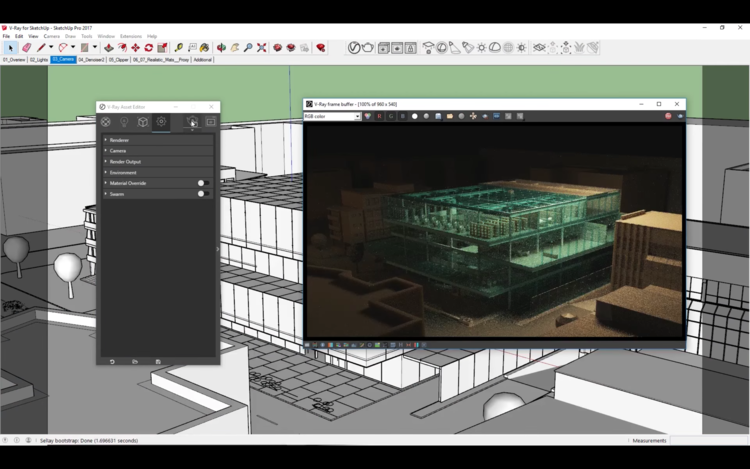
Virtual reality was never going to look like The Lawnmower Man forever. As VR/AR use continues to grow, users are demanding clearer, crisper immersive environments, and they’re not likely to stop till the line between the virtual and real is seamless. This is where Chaos Group comes in. The digital graphics firm’s V-Ray technology strives to make the imaginary as photo-realistic as possible—in film, in animation, and in architectural renderings and models.

If you’re lucky enough to have a ticket to the upcoming BuiltWorlds Summit 2017, our annual event bringing experts together from a broad spectrum of AEC disciplines, you’ll get to hear from Chaos Group’s chief commercial officer, Lon Grohs, tomorrow morning. He’s part of a panel on VR/AR—also including Ryan Salvas, director of innovation for Skanska USA; Ken Hepburn, a managing partner at NextDTech; and Tim Bakos, director of operations for Perkins + Will—and he’s likely to discuss the latest enhancements in his firm’s technology.
If you don’t have a ticket, though, you can still get a few insights from our interview with Grohs below. He spoke with us ahead of the summit about how his firm’s VR technology is being implemented by architecture and construction companies, why architecture firms are among the most likely to lead the way in VR/AR advancement, and how long he thinks it will be before the technology is widespread in the AEC industry.
Talk a little bit about your background. How’d you make the move from architecture to VR?
I actually went to school for architecture and then worked for an architecture firm in Boston right out of college. I quickly got into 3-D design, working on visualization and computer graphics.
After a few years, I teamed up with a company called Neoscape on the East Coast. They’re in Boston and New York, and they handle visualization for high-end real estate projects. If somebody is building a brand-new skyscraper, they’re one of the few firms that often gets tapped to do the visualization. We were working in 3-D models, 3-D visualization, animation, interactive—basically, any way that you could portray architecture at that time, including Quicktime VR, which pales in comparison to today’s VR capabilities, but it was a starting point.
And when did you get to Chaos Group?
In 2011, I moved from Neoscape to Chaos Group, known for its rendering software, V-Ray. V-Ray takes a 3-D model—any 3-D model that you build—and allows you to apply distinct materials, real lighting, camera controls. It basically allows you to take a 3-D model and turn it into something that looks akin to a photograph. I think 92 of the top 100 architecture firms in the world are V-Ray customers. It’s actually a plug-in that connects to Autodesk 3ds Max or Autodesk Revit or Trimble’s SketchUp or McNeel’s Rhino. It really covers the tools that architects are using these days.
Are you seeing it being used by contractors as well?
To a certain degree. Traditionally contractors say they don’t need the renderings to look that realistic, although some do. Some do really elaborate construction sequencing animations and other things like that.
We’re known for photo-realism, but photo-realism isn’t the only thing you can get out of V-Ray. You could render something that looks basically any way you want it to, whether you want it to look like a physical model or more of a graphic representation.
It seems like I keep reading more and more about stakeholders trying to get everybody in on BIM modeling and the modeling process as early as possible, so I guess I’m wondering if you’re seeing more than just architects using it.
Yeah, I mean, one of the things that we’re trying to do with V-Ray is make sure it’s easy enough to use at any stage of the design process so that someone could use it as a push-button solution to get what they want out of it. [It] has some VR capabilities built in, to where you’re able to quickly render out something and look at it on Google Cardboard, Gear VR, etcetera.
VR, in its many flavors, is definitely being looked at all throughout the process, especially construction—and AR as well. You could see something partially constructed and then know what it’s going to look like in the context of where it is.
And moving into the future a little bit, Goldman Sachs is predicting that the AR/VR market is going to explode in the next decade. How much do you see that explosive growth extending to the AEC industry?
One of the things I find fascinating is that while there’s Facebook and Oculus and so on that are looking at consumer-level VR—they’re pushing ways for you to collaborate over VR or turn that into a social sphere—what we’re finding in a practical sense, right now, [is that] architecture, in a lot of ways, is leading the way for VR.
Why is that?
You no longer have to work at scale. Now you can actually build a 3-D model, put on your goggles, and see that one-to-one scale without building, and that is a huge advantage for people who are dealing with anything that’s not built. It could be early on, just looking at massings, it could be as you’re trying to rectify a detail, it could be all the way through construction. The ability to see something at scale is like a superpower for architects, so I think architecture is going to be one of the professions that leads the way for VR. It just makes too much sense.
And as architecture leads the way, what is Chaos Group doing to keep V-Ray on the cutting edge?
With our core strength being photo-real visualization, we’ve already been able to create 100 percent photo-real experiences of not-yet-built work with three degrees of freedom. Three degrees of freedom is, you can stand in one place and move your head around and see things at scale. But, you can’t move in the space; that’s something that we’re working on with a couple of other technology partners. That’s six degrees of freedom: a completely realistically rendered experience of whatever architectural space that you want, and you can move within room scale. We’re at the bleeding edge of that right now. We’ve got this demo that would actually allow you to walk around a photo-realistic environment that has been totally prerendered.
How far out would you estimate that capability is from being the norm?
We announced the technology partnership with a company called Nozon [creator of PresenZ] at the tail end of last year, and they’ve since gone through an acquisition, and they’re coming out of that acquisition. I would say in the next few months, we should have something to market that would allow people to begin to experiment with prerendered six degrees of freedom.
Are there longer-term goals that Chaos Group has for V-Ray or more distant predictions that you have for VR/AR in the AEC space in general?
You know, for us, one of the things that excites us is that our core technology, a ray-tracing technology, can be used in a lot of different ways. We can be used in VR already with three degrees of freedom or six degrees of freedom coming up, and we’ll only get better and more optimized. But, as we approach AR, I haven’t seen anybody do a fully ray-traced AR experience yet, and by ray-tracing, I mean instead of a gaming engine, you’re doing something that is akin to the photo-realism that you’d see in a movie. Our core technology—which is also used in feature film and so on—could be used in AR to realistically render into the built world. It doesn’t have to look like it’s tacked on or some kind of different alternate universe; it could look like it actually fits in that world.
Imagine you go to a building site and you have your AR goggles on, and instead of looking at the new skyscraper that’s coming out as a model or a graphic representation, you could potentially get to the point where you look at that and it is 100 percent real—matches the sun angle, matches the reflection, all of that. It would take some math and computing power, so I could be wrong, but it’s something that could be possible.
“What we’re finding in a practical sense, right now, [is that] architecture, in a lot of ways, is leading the way for VR.
The sheer amount of computing power needed sounds like one of the big obstacles for VR/AR. Are there other big obstacles that you foresee?
Computing power is going to be one; with the advent of the cloud and the increasing horsepower that you get from cloud computing, we’re seeing those barriers start to go away a little bit. Optimization is one, and this is specifically for trying to get photo-real, ray-traced content done.
And then, I honestly think one of the biggest challenges right now is workflow and comfort level. Right now, to get something into a truly interactive six-degrees-of-freedom environment, it takes specialized tools, specialized skillsets, somebody to understand how to program or get something into a real-time engine. That’s one of the things that we’re hopefully trying to do away with, to make it more of a push-button solution.
And then there’s an overall comfort level [with] the headsets. Not everybody wants to put the damn things on, honestly. It’s going to be one of those things where it’ll take time. Not everybody wanted to use the mouse when it first came about. They still had arrow keys on the keyboard, and Steve Jobs threw a fit and took them off and forced you to use the mouse.
The other challenge I see is that the investment in the technology at this point is so deep that they’re kind of desperate to make it not fail. But, if the consumer market’s fading—let’s say this is a repeat of 3-D television—I don’t know where that’s going to leave the professionals in this case. Like I said, architecture’s got a huge vested interest in this. But, if the numbers don’t add up to a [company like] Facebook, who’s invested $2 billion in it, where does that leave it? I don’t think it will go away, but it could stunt the growth. It could stunt the rate at which things develop.
In your estimation, when do you see VR/AR technology becoming commonplace in the AEC industry?
Three years? Maybe three years is optimistic. Five years seems too long. I think as people start to see the benefits outweigh those things, they’ll be naturally drawn. And of course the technology of the headsets should and will get better. I think it’s also fine-tuning the use case. Right now it all seems very experimental, but once you can get a few projects under way that prove its worth, then that’s the kind of thing that takes off.

Discussion
Be the first to leave a comment.
You must be a member of the BuiltWorlds community to join the discussion.